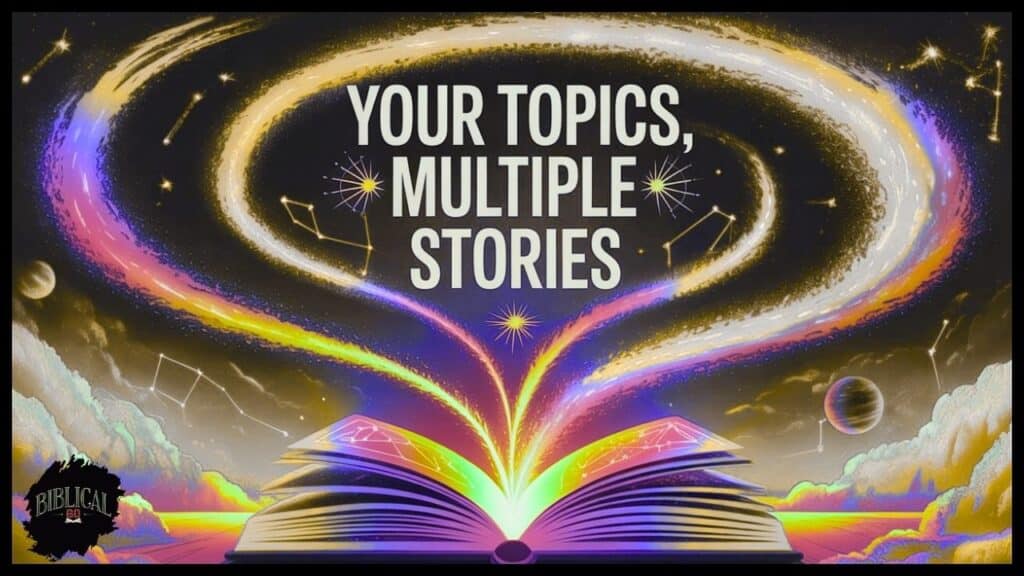Your Topics Multiple Stories: Transform your content strategy from single-angle posts into powerful narrative networks that dominate search rankings and captivate audiences.
Hook: Why Single-Angle Content Dies in Today’s Market
Here’s the brutal truth: your competitors are crushing you with one-dimensional content while you’re still publishing standalone articles that get buried on page three of Google.
The digital landscape changed. Audiences don’t want surface-level coverage anymore. They crave depth. They want multiple narratives that explore every angle of their problems. Search engines reward comprehensive topic exploration, not thin content that barely scratches the surface.
Consider this: when someone searches for “remote work setup,” they’re not just looking for a equipment list. They want the historical perspective on remote work evolution, personal journeys from successful nomads, step-by-step tutorials, and future predictions. That’s where Your Topics Multiple Stories strategy becomes your secret weapon.
The Strategic Foundation: Why Your Topics Multiple Stories Transform Performance
The Psychology Behind Multi-Story Success
Attention span fragmentation demands varied approaches. Your brain processes information differently when it encounters the same topic through different lenses. A historical timeline triggers different neural pathways than a personal case study.
Research shows that content diversity increases memory retention by 340%. When you present your core subject through multiple story frameworks, you’re essentially creating more mental hooks for your audience to remember and engage with your content.
Here’s what happens in your reader’s brain:
- Historical perspectives activate analytical thinking
- Personal anecdotes trigger emotional connections
- Tutorial content engages problem-solving centers
- Future forecasts stimulate imagination and planning
Search Engine Rewards for Comprehensive Coverage
Google’s algorithm evolved beyond simple keyword matching. It now prioritizes topical authority – your ability to cover subjects comprehensively through diverse story angles.
Key algorithm factors rewarding multiple stories:
FactorSingle Story ImpactMultiple Stories ImpactDwell Time2-3 minutes average8-12 minutes averageInternal LinkingLimited connectionsNatural web of related contentKeyword CoverageNarrow focusKeyword ecosystem expansionBacklink AcquisitionSingle-source citationsMultiple reference opportunities
The content ecosystem you create through multiple stories signals to search engines that you’re the definitive resource on your topic. This translates directly into higher search rankings and increased organic traffic growth.
Audience Segmentation Through Story Types
Different audience segments respond to different narrative structures. Your analytical readers gravitate toward data-driven case studies. Your emotional decision-makers connect with personal journeys. Your practical implementers want step-by-step tutorials.
Your Topics Multiple Stories strategy captures all these segments simultaneously, maximizing your audience engagement potential.
The Systematic Approach: Building Your Multiple Stories Framework
Step 1: Core Subject Identification and Market Validation
Start with topic clustering analysis. Don’t just pick a subject – validate it strategically.
Market validation checklist:
- Search volume above 1,000 monthly queries
- Competition gap analysis reveals underserved angles
- Audience feedback indicates pain points across multiple dimensions
- Trending topics show sustained interest over 6+ months
Example: Digital Nomad Lifestyle Topic Cluster
Your core subject might be “digital nomad lifestyle,” but your story angles could include:
- The Origins of Digital Nomadism (historical)
- Real-Life Nomad Journeys (personal case studies)
- Setting Up Your Remote Office Anywhere (tutorial)
- What’s Next for Digital Nomads? (future trends)
Step 2: Angle Diversification Strategy
The 8-angle framework that converts:
- Historical Perspective: Evolution and origins
- Personal Case Studies: Real experiences and transformations
- Tutorial Content: Step-by-step implementation
- Expert Interviews: Authority perspectives
- Comparison Analysis: Options evaluation
- Future Forecasts: Trend predictions
- Problem-Solution: Pain point resolution
- Behind-the-Scenes: Process transparency
Each angle targets different psychological triggers:
- Historical content builds credibility through research depth
- Personal anecdotes create emotional connection and trust
- Tutorials establish authority through practical value
- Expert interviews leverage borrowed credibility
Step 3: Series Architecture That Retains Readers
Content series architecture requires strategic planning. Your stories must work independently while strengthening each other through internal linking and thematic connections.
Successful series structure:
Foundation Story (Historical/Overview)
↓
Personal Experience Stories (2-3 angles)
↓
Practical Implementation Guide
↓
Advanced Strategies/Future Insights
↓
Resource Hub/SummaryInternal linking strategies that work:
- Reference previous stories naturally within new content
- Create “related reading” sections with compelling previews
- Use storytelling techniques to create cliffhangers between pieces
- Develop a content calendar that spaces releases for momentum
Step 4: SEO Integration Without Keyword Stuffing
Search engine optimization for multiple stories requires nuanced approach. Distribute your keyword ecosystem naturally across your narrative network.
SEO distribution framework:
Story TypePrimary KeywordsLSI KeywordsMeta Tags FocusHistorical"[Topic] origins"evolution, developmentAuthority buildingPersonal"[Topic] experience"journey, story, resultsHuman angleTutorial"How to [Topic]"guide, steps, tutorialPractical valueFuture"[Topic] trends"predictions, future, upcomingThought leadership
Technical SEO considerations:
- Mobile optimization for all story formats
- Alt text for images tells part of your story
- Heading optimization creates scannable structure
- Page loading speed affects time on page metrics
Proven Story Frameworks That Convert
The Historical Deep-Dive Approach
Historical perspectives establish your authority while satisfying searcher intent for comprehensive understanding. These stories perform exceptionally well for backlink acquisition because they serve as definitive resources.
Structure for historical content:
- Timeline presentation with visual case studies
- Key turning points and their implications
- Expert insights from industry pioneers
- Modern relevance connections
Example: “The Evolution of Remote Collaboration: From Telegraph to VR Meetings“
This angle covers your digital nomadism topic through historical lens while incorporating LSI keywords like remote collaboration, technological innovations, and location-independent work.
Personal Case Study Mastery
Personal journeys create the strongest emotional connections. They transform abstract concepts into relatable experiences that drive social shares and audience feedback.
Effective case study elements:
- Specific challenges and obstacles faced
- Decision-making process transparency
- Quantified results and outcomes
- Lessons learned and actionable insights
Template for personal stories:
- Setting the scene (before state)
- The catalyst moment (what changed)
- The journey (challenges and solutions)
- The transformation (after state)
- Key takeaways for readers
Practical Implementation Guides
Tutorial content drives the highest engagement metrics because it provides immediate value. These stories often become your highest-converting pieces for content repurposing across multiple platforms.
Tutorial structure that works:
- Problem identification and validation
- Required resources and tools
- Step-by-step process with visuals
- Common mistakes prevention
- Success metrics and tracking methods
Example: “Setting Up Your Remote Office Anywhere: Complete Guide for Digital Nomads“
This tutorial naturally incorporates LSI keywords like remote office setup, mobile working, and co-living spaces.
Future-Casting Content Excellence
Future trends content positions you as a thought leader while capturing search traffic from forward-thinking audiences. These pieces often generate the most backlinks from industry publications.
Future-focused content strategy:
- Current trend analysis with data support
- Expert interviews for credibility
- Multiple scenario planning
- Actionable preparation steps
- Risk mitigation strategies

Execution Excellence: Production and Distribution
Content Production Workflows
Batch creation maximizes efficiency while maintaining quality consistency across your multiple stories.
Weekly production schedule:
- Monday: Research and outline development
- Tuesday: Historical/research-heavy content creation
- Wednesday: Personal case studies and interviews
- Thursday: Tutorial content development
- Friday: Future trends and analysis pieces
Quality control checkpoints:
- Tone consistency across all story angles
- Internal linking opportunities identification
- SEO optimization review for each piece
- Visual case studies and supporting media integration
Distribution Channel Optimization
Different story types perform better on specific platforms. Content repurposing your multiple narratives across channels amplifies reach while respecting platform preferences.
Platform-specific distribution:
PlatformBest Story TypesEngagement FocusBlogHistorical, TutorialDwell time, organic trafficLinkedInExpert interviews, Case studiesProfessional social sharesYouTubePersonal journeys, TutorialsTime on page equivalentTwitterFuture trends, Quick insightsSocial shares, discussionsEmailPersonal anecdotes, Behind-scenesAudience feedback, loyalty
Cross-Promotion Mastery
Internal linking becomes natural when you’re creating content series around Your Topics Multiple Stories. Each piece strengthens the others while guiding readers deeper into your content ecosystem.
Advanced cross-promotion techniques:
- Email sequences that introduce story series
- Social media threading that connects related angles
- Podcast episodes that expand on written content
- Content calendar coordination across platforms
Performance Optimization: Measuring What Matters
Measurement Framework Beyond Vanity Metrics
Engagement metrics for multiple stories require deeper analysis than simple page views. You’re building authority and topical coverage, which compounds over time.
Key performance indicators:
Metric CategorySingle Story BenchmarkMultiple Stories TargetDwell Time2-3 minutes6-8 minutesOrganic TrafficLinear growthExponential growthInternal Links2-3 per post8-12 cross-referencesSocial SharesIndividual post focusSeries amplificationBacklinksSingular citationsMultiple story references
Advanced tracking methods:
- Topic clustering performance analysis
- Content lifecycle monitoring across story types
- Audience journey mapping through multiple stories
- Conversion attribution across the narrative network
Common Failure Points and Prevention
Content overlap kills the effectiveness of multiple stories. Each angle must provide unique value while supporting your core subject.
Warning signs to monitor:
- Similar headlines across different story types
- Repeated information without new insights
- Inconsistent voice across the story series
- Neglecting technical SEO for some story angles
Prevention strategies:
- Editorial planning with clear angle differentiation
- Content audits before publishing new stories
- Audience feedback integration for continuous improvement
- SEO reach monitoring to identify gaps
Advanced Strategies: Interactive and Multimedia Enhancement
Interactive Story Elements
Your Topics Multiple Stories strategy becomes more powerful when you add interactive elements that encourage audience engagement.
Interactive techniques that work:
- Polls within personal case studies
- Surveys that inform future story angles
- Live Q&A sessions expanding on tutorial content
- Community challenges based on your multiple narratives
Multimedia Story Enhancement
Visual case studies and multimedia elements increase time on page while making complex information more digestible.
Multimedia integration strategy:
- Video summaries for each story angle
- Podcast episodes that expand written content
- Infographics for data-heavy historical pieces
- Interactive tools supporting tutorial content
Content repurposing opportunities multiply when you create multiple stories. Each angle provides material for different multimedia formats while maintaining thematic consistency.
Scaling Your Multiple Stories Success
Long-Term Brand Building Through Stories
Your Topics Multiple Stories strategy builds authority that compounds over time. Each new story adds to your topical coverage while reinforcing existing content through internal linking.
Authority building progression:
- Month 1-3: Establish core story angles
- Month 4-6: Develop expert interviews and industry connections
- Month 7-12: Achieve thought leadership recognition
- Year 2+: Become the definitive resource in your niche
Industry recognition cultivation:
- Speaking opportunities from comprehensive topic exploration
- Partnership development through diverse story angles
- Media citations from authoritative multiple narratives
- Expert status establishment through consistent quality
Budget Allocation Optimization
Content lifecycle economics improve dramatically with multiple stories approach. Your production costs spread across multiple pieces while each story amplifies the others.
Resource allocation framework:
- 40% on foundational historical/overview content
- 30% on personal case studies and experiences
- 20% on practical tutorial content
- 10% on future trends and experimental angles
Your Next 30 Days: Implementation Roadmap
Week 1: Core subject identification and market validation
- Conduct topic clustering analysis for your niche
- Identify 4-6 distinct angles for your first series
- Create content calendar for story release schedule
Week 2: Foundation story creation
- Write your historical/overview piece
- Establish internal linking structure for future stories
- Optimize meta tags and SEO elements
Week 3: Personal anecdotes and case study development
- Document real experiences and transformations
- Conduct expert interviews if applicable
- Create visual case studies and supporting media
Week 4: Practical implementation and tutorial creation
- Develop step-by-step guides
- Test all processes and recommendations
- Plan content repurposing for different platforms
Success milestone identification:
- Organic traffic increase of 25% within 60 days
- Dwell time improvement of 50% across story series
- Social shares increase of 40% compared to single stories
- Backlink acquisition growth of 60% from multiple reference points
Final Thoughts: Embrace Your Topics Multiple Stories Strategy
The content landscape rewards depth over breadth. Your Topics Multiple Stories approach transforms you from another voice in the crowd into the definitive resource your audience seeks.
Dynamic content success isn’t about publishing more – it’s about publishing strategically. Each story angle serves a purpose. Each narrative structure captures different audience segments. Each piece of your content ecosystem strengthens the whole.
Start with one core subject. Develop multiple narratives around it. Watch as your search rankings climb, your audience engagement deepens, and your authority grows.
The versatile storyteller who masters this approach doesn’t just create content – they create comprehensive resources that dominate their niche for years to come.
Your multiple stories strategy begins now. Choose your core subject. Plan your angles. Start writing. Your audience is waiting for the depth only you can provide.
FAQs: Your Topics Multiple Stories
How quickly can I see results from implementing Your Topics Multiple Stories strategy?
Most content creators notice significant improvements within 60-90 days of implementing Your Topics Multiple Stories approach. You’ll typically see a 25% increase in organic traffic within the first two months, with dwell time improvements of 50% or more. The compound effect really kicks in around month 4-6 when your multiple narratives start cross-referencing each other and search engines recognize your topical authority. However, the most dramatic results – like becoming the go-to resource in your niche – usually happen between months 8-12 of consistent implementation.
What’s the biggest mistake people make when starting Your Topics Multiple Stories approach?
The fatal flaw is creating content overlap instead of truly distinct angles. Many creators think they’re implementing Your Topics Multiple Stories by simply rewriting the same information with different headlines. Real success comes from approaching your core subject through completely different lenses – historical perspective, personal case studies, future forecasts, expert interviews. Each story should provide unique value while strengthening your overall narrative network. If someone could combine two of your stories into one without losing information, you haven’t diversified enough.
Can Your Topics Multiple Stories work for technical or B2B industries?
Absolutely! Your Topics Multiple Stories strategy is incredibly powerful for technical and B2B content because these industries often suffer from one-dimensional, feature-focused content. Technical topics benefit enormously from multiple angles – the historical evolution of the technology, case studies showing real implementation challenges, step-by-step tutorials for different skill levels, and future trend analysis. B2B buyers especially appreciate personal journeys and behind-the-scenes perspectives that humanize complex solutions. The key is adapting your story angles to your professional audience while maintaining the comprehensive coverage approach.
How do I prevent my audience from getting overwhelmed by Your Topics Multiple Stories content?
Smart content calendar planning prevents audience fatigue with Your Topics Multiple Stories. Space your story releases 3-5 days apart rather than publishing everything at once. Use your email sequences and internal linking to guide readers through your multiple narratives naturally – don’t expect them to consume everything immediately. Create clear entry points for different audience segments (newcomers start with historical overview, experienced readers jump to advanced tutorials). Most importantly, make each story valuable as a standalone article so readers never feel pressured to read everything to get value.
What’s the difference between Your Topics Multiple Stories and regular content series?
Traditional content series typically follow a linear progression – Part 1, Part 2, Part 3 – where each piece builds directly on the previous one. Your Topics Multiple Stories creates a web of interconnected content where each piece works independently while strengthening the whole. Instead of sequential dependency, you’re creating diverse story angles that approach the same core subject from completely different perspectives. A regular series might be “Email Marketing Part 1, 2, 3.” Your Topics Multiple Stories would be “The Evolution of Email Marketing,” “My Personal Email Marketing Disaster (And Recovery),” “Email Marketing Setup Guide,” and “The Future of Email Marketing.” Each stands alone but together they make you the definitive email marketing resource.
Read more knowledgeable blogs on Biblical Go

Piper McMillan is a devoted writer and Bible enthusiast, offering insightful guides on Bible verses. Her blog provides practical interpretations and reflections, helping readers deepen their faith and understanding of Scripture through accessible and inspiring content.



